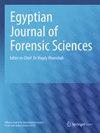Metric and morphological features of the ear in sex classification
IF 1.3
Q3 MEDICINE, LEGAL
引用次数: 0
Abstract
Abstract Background The human face can reveal a great deal about a person’s identity. Age, sex, and ethnicity differences can be recognized, classified, and analyzed using facial features, which give a scientific basis for personal identification and recognition. Sex, like age and ethnicity, has a significant influence on outer ear morphology. The shape and size of the auricle, which is one of the defining features of the face, are affected by age, sex, and ethnicity. Variations in the outer ear are known to be sufficient for identification in a forensic case and can help in determining whether the suspect is guilty or not. The aim of this research is to determine whether such metric and morphological features of the ear can be used to estimate sex and how dimorphic they are. After ear measurements with ImageJ 1.52a program, statistical data was recorded and analyzed in SPSS. Results This study, which analyzed 350 people’s facial images, provides significant information for forensic applications. Among the analyzed ear morphology data, the helix and ear lobe form showed sex differences. Except for the T-PCC distance, all measurements differed significantly between sexes. Conclusions Model 1 has the greatest accuracy rate (88%) among the models created for sex estimation. Sex estimation can be performed as an effective method when the morphological and metric parameters of the ear are analyzed together.性别分类中耳的尺度和形态特征
人脸可以揭示一个人的很多身份信息。面部特征可以识别、分类和分析年龄、性别和种族的差异,为个人识别和识别提供科学依据。性别,像年龄和种族一样,对外耳形态有重大影响。耳廓的形状和大小是面部的决定性特征之一,受年龄、性别和种族的影响。众所周知,外耳的变化足以在法医案件中进行识别,并有助于确定嫌疑人是否有罪。这项研究的目的是确定耳朵的这种度量和形态特征是否可以用来估计性别,以及它们是如何二态的。用ImageJ 1.52a程序测耳后,用SPSS统计软件记录统计数据并进行分析。结果本研究分析了350人的面部图像,为法医应用提供了重要信息。在分析的耳部形态数据中,螺旋形和耳垂形存在性别差异。除T-PCC距离外,所有测量值在两性之间均存在显著差异。结论模型1在性别估计模型中准确率最高(88%)。将耳的形态参数和度量参数结合起来进行性别估计是一种有效的方法。
本文章由计算机程序翻译,如有差异,请以英文原文为准。
求助全文
约1分钟内获得全文
求助全文
来源期刊

Egyptian journal of forensic sciences
MEDICINE, LEGAL-
CiteScore
2.00
自引率
0.00%
发文量
51
审稿时长
17 weeks
期刊介绍:
Egyptian Journal of Forensic Sciences, the official publication of The International Association of Law and Forensic Sciences (IALFS), is an open access journal that publishes articles in the forensic sciences, pathology and clinical forensic medicine and its related specialities. The journal carries classic reviews, case studies, original research, hypotheses and learning points, offering critical analysis and scientific appraisal.
 求助内容:
求助内容: 应助结果提醒方式:
应助结果提醒方式:


